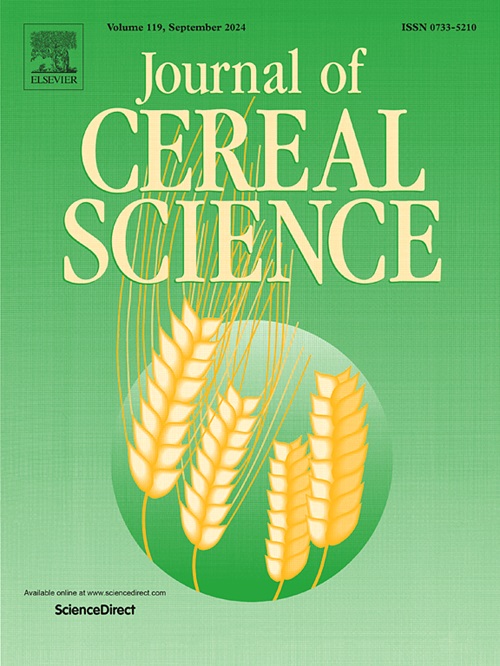Assessing phytochemical composition, technological quality, and yield traits of blue, purple, and black wheat genotypes for colored wheat-derived products
IF 3.7
2区 农林科学
Q2 FOOD SCIENCE & TECHNOLOGY
引用次数: 0
Abstract
Colored-grain wheat enriches functional foods and diverse diets by providing significant health benefits. This study evaluated the yield, technological quality, and phytochemical properties of nineteen blue, purple, and black wheat genotypes, comparing them with two bread (red) and two durum (amber) common-colored wheat genotypes. In the analysis of ZSED, LASRC, SIG, MSDS, PMT, AM, and FWA, which were indicative of gluten quality, bread wheat genotypes were ranked as red > purple > blue. The purple genotypes CCP23.D1159-4, CID.CCP37, P.la.P. 31, and P.la.P. 2, along with the blue genotypes X1-15 and X.13.5, proved to have better gluten quality suitable for colored bread-making. Meanwhile, Blue Norco was suggested for producing colored-blue biscuits due to its low grain hardness and weak gluten quality. The blue genotypes Skot.Th.Blue 8, X.13.5, and a purple genotype CID.CCP37 also indicated superiority in antioxidant capacity, TPC, and TAC. Additionally, compared to red/amber genotypes, the average results of blue and purple genotypes consistently contained better antioxidant capacity in DPPH, CUPRAC, FRAP, and MC tests as well as TPC, TFC, TCC, and TAC. The study suggested that the selected colored wheat genotypes with their yield, gluten quality and phytochemical profiles can be promising candidates for inclusion in breeding programs.

评估蓝色、紫色和黑色小麦基因型用于彩色小麦衍生产品的植物化学成分、技术质量和产量特性
彩色谷物小麦通过提供显著的健康益处,丰富了功能性食品和多样化的饮食。本研究评估了19种蓝色、紫色和黑色小麦基因型的产量、技术品质和植物化学特性,并将它们与两种面包(红色)和两种硬粒(琥珀色)普通小麦基因型进行了比较。在对代表面筋品质的ZSED、LASRC、SIG、MSDS、PMT、AM和FWA的分析中,面包小麦的基因型为红色;紫色的祝辞蓝色的。紫色基因型为CCP23。D1159-4, CID。CCP37 P.la.P。31、p。2、蓝色基因型X1-15和X.13.5具有较好的面筋品质,适合制作彩色面包。同时,Blue Norco因其颗粒硬度低、面筋质量差,被推荐用于生产彩蓝饼干。蓝色基因型Skot.Th.Blue 8, X.13.5,紫色基因型CID。CCP37在抗氧化能力、TPC和TAC方面也具有优势。此外,与红色/琥珀色基因型相比,蓝色和紫色基因型的平均结果在DPPH、CUPRAC、FRAP和MC测试以及TPC、TFC、TCC和TAC中始终具有更好的抗氧化能力。该研究表明,所选的彩色小麦基因型及其产量、面筋质量和植物化学特征可以作为有希望的候选品种纳入育种计划。
本文章由计算机程序翻译,如有差异,请以英文原文为准。
求助全文
约1分钟内获得全文
求助全文
来源期刊

Journal of Cereal Science
工程技术-食品科技
CiteScore
7.80
自引率
2.60%
发文量
163
审稿时长
38 days
期刊介绍:
The Journal of Cereal Science was established in 1983 to provide an International forum for the publication of original research papers of high standing covering all aspects of cereal science related to the functional and nutritional quality of cereal grains (true cereals - members of the Poaceae family and starchy pseudocereals - members of the Amaranthaceae, Chenopodiaceae and Polygonaceae families) and their products, in relation to the cereals used. The journal also publishes concise and critical review articles appraising the status and future directions of specific areas of cereal science and short communications that present news of important advances in research. The journal aims at topicality and at providing comprehensive coverage of progress in the field.
 求助内容:
求助内容: 应助结果提醒方式:
应助结果提醒方式:


